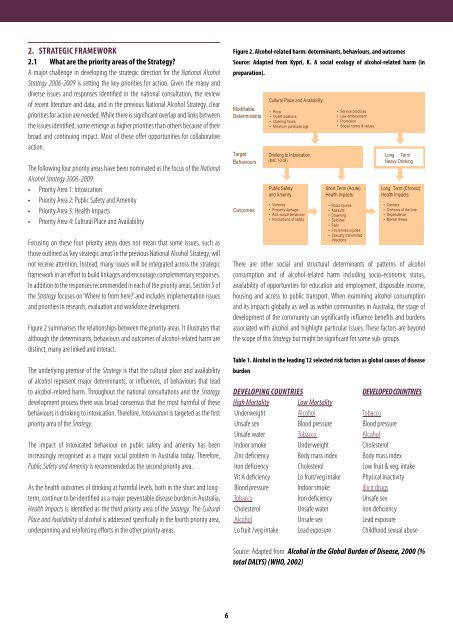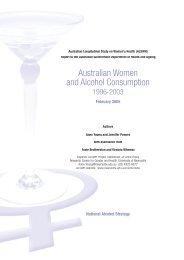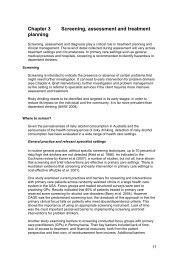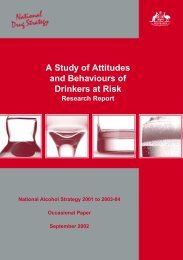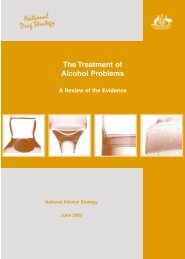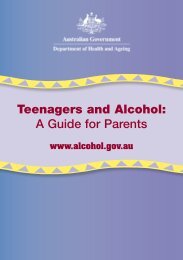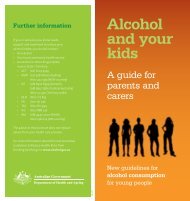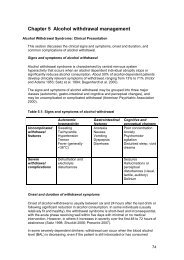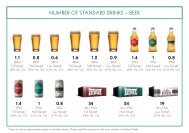National Drug Strategy 2006-2009 - part 1 - posted 18/08/06 - Alcohol
National Drug Strategy 2006-2009 - part 1 - posted 18/08/06 - Alcohol
National Drug Strategy 2006-2009 - part 1 - posted 18/08/06 - Alcohol
You also want an ePaper? Increase the reach of your titles
YUMPU automatically turns print PDFs into web optimized ePapers that Google loves.
2. STRATEGIC FRAMEWORK2.1 What are the priority areas of the <strong>Strategy</strong>?A major challenge in developing the strategic direction for the <strong>National</strong> <strong>Alcohol</strong><strong>Strategy</strong> <strong>20<strong>06</strong></strong>-<strong>2009</strong> is setting the key priorities for action. Given the many anddiverse issues and responses identified in the national consultation, the reviewof recent literature and data, and in the previous <strong>National</strong> <strong>Alcohol</strong> <strong>Strategy</strong>, clearpriorities for action are needed. While there is significant overlap and links betweenthe issues identified, some emerge as higher priorities than others because of theirbroad and continuing impact. Most of these offer opportunities for collaborativeaction.Figure 2. <strong>Alcohol</strong>-related harm: determinants, behaviours, and outcomesSource: Adapted from Kypri, K. A social ecology of alcohol-related harm (inpreparation).The following four priority areas have been nominated as the focus of the <strong>National</strong><strong>Alcohol</strong> <strong>Strategy</strong> <strong>20<strong>06</strong></strong>-<strong>2009</strong>:• Priority Area 1: Intoxication• Priority Area 2: Public Safety and Amenity• Priority Area 3: Health Impacts• Priority Area 4: Cultural Place and AvailabilityFocusing on these four priority areas does not mean that some issues, such asthose outlined as ‘key strategic areas’ in the previous <strong>National</strong> <strong>Alcohol</strong> <strong>Strategy</strong>, willnot receive attention. Instead, many issues will be integrated across the strategicframework in an effort to build linkages and encourage complementary responses.In addition to the responses recommended in each of the priority areas, Section 5 ofthe <strong>Strategy</strong> focuses on ‘Where to from here?’ and includes implementation issuesand priorities in research, evaluation and workforce development.Figure 2 summarises the relationships between the priority areas. It illustrates thatalthough the determinants, behaviours and outcomes of alcohol-related harm aredistinct, many are linked and interact.The underlying premise of the <strong>Strategy</strong> is that the cultural place and availabilityof alcohol represent major determinants, or influences, of behaviours that leadto alcohol-related harm. Throughout the national consultations and the <strong>Strategy</strong>development process there was broad consensus that the most harmful of thesebehaviours is drinking to intoxication. Therefore, Intoxication is targeted as the firstpriority area of the <strong>Strategy</strong>.The impact of intoxicated behaviour on public safety and amenity has beenincreasingly recognised as a major social problem in Australia today. Therefore,Public Safety and Amenity is recommended as the second priority area.As the health outcomes of drinking at harmful levels, both in the short and longterm,continue to be identified as a major preventable disease burden in Australia,Health Impacts is identified as the third priority area of the <strong>Strategy</strong>. The CulturalPlace and Availability of alcohol is addressed specifically in the fourth priority area,underpinning and reinforcing efforts in the other priority areas.There are other social and structural determinants of patterns of alcoholconsumption and of alcohol-related harm including socio-economic status,availability of opportunities for education and employment, disposable income,housing and access to public transport. When examining alcohol consumptionand its impacts globally as well as within communities in Australia, the stage ofdevelopment of the community can significantly influence benefits and burdensassociated with alcohol and highlight <strong>part</strong>icular issues. These factors are beyondthe scope of this <strong>Strategy</strong> but might be significant for some sub-groups.Table 1. <strong>Alcohol</strong> in the leading 12 selected risk factors as global causes of diseaseburdenDEVELOPING COUNTRIESDEVELOPED COUNTRIESHigh MortalityLow MortalityUnderweight <strong>Alcohol</strong> TobaccoUnsafe sex Blood pressure Blood pressureUnsafe water Tobacco <strong>Alcohol</strong>Indoor smoke Underweight CholesterolZinc deficiency Body mass index Body mass indexIron deficiency Cholesterol Low fruit & veg. intakeVit A deficiency Lo fruit/veg intake Physical inactivityBlood pressure Indoor smoke Illicit drugsTobacco Iron deficiency Unsafe sexCholesterol Unsafe water Iron deficiency<strong>Alcohol</strong> Unsafe sex Lead exposureLo fruit /veg intake Lead exposure Childhood sexual abuseSource: Adapted from <strong>Alcohol</strong> in the Global Burden of Disease, 2000 (%total DALYS) (WHO, 2002)6


